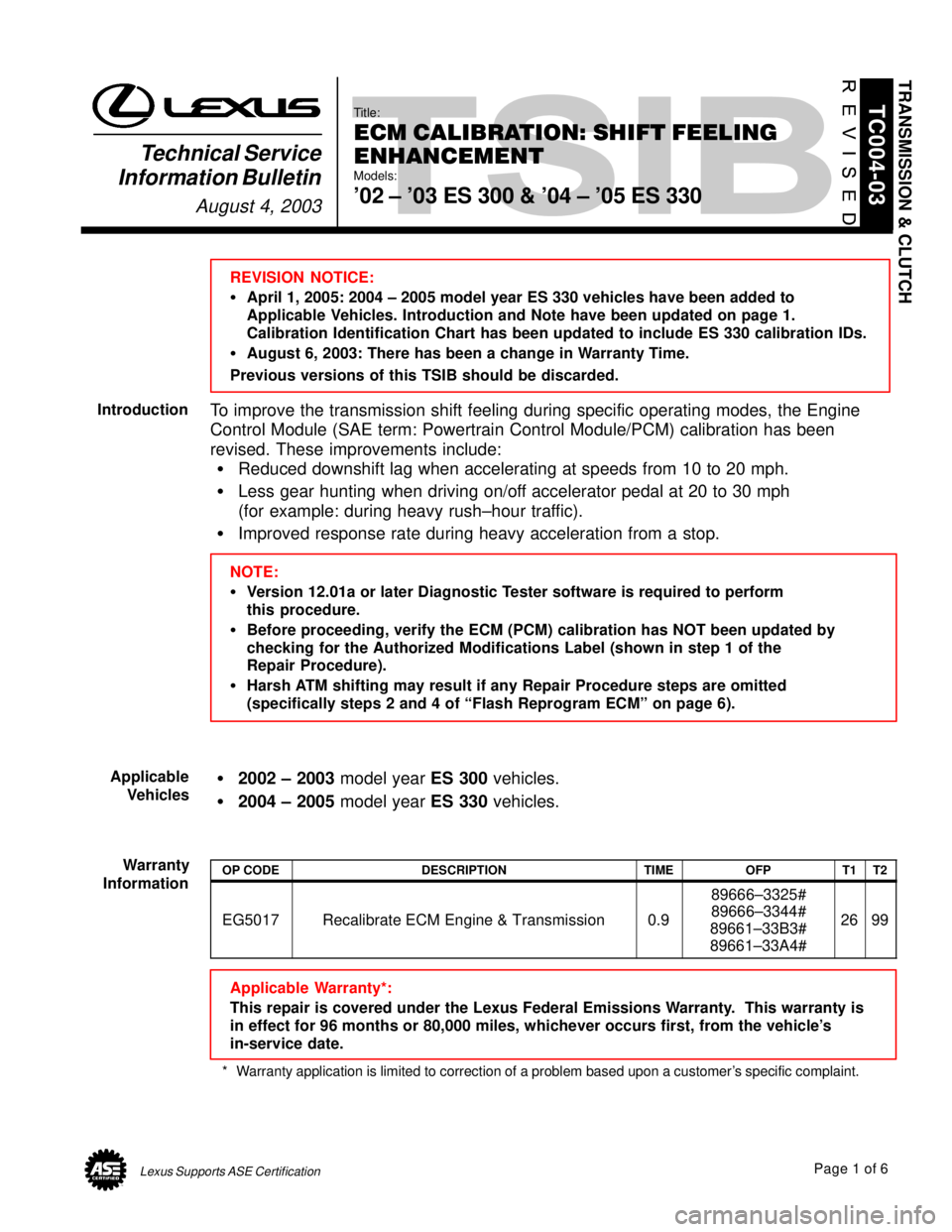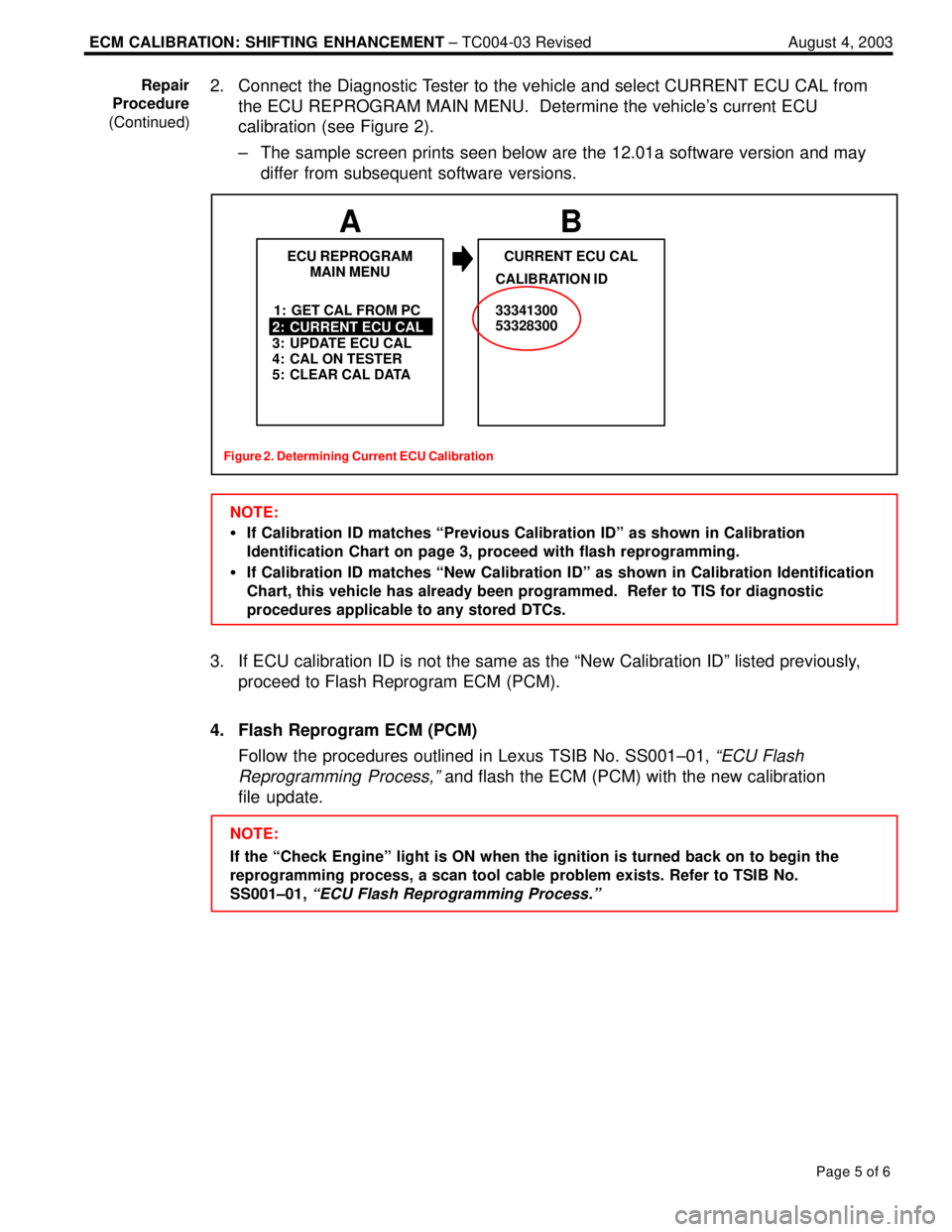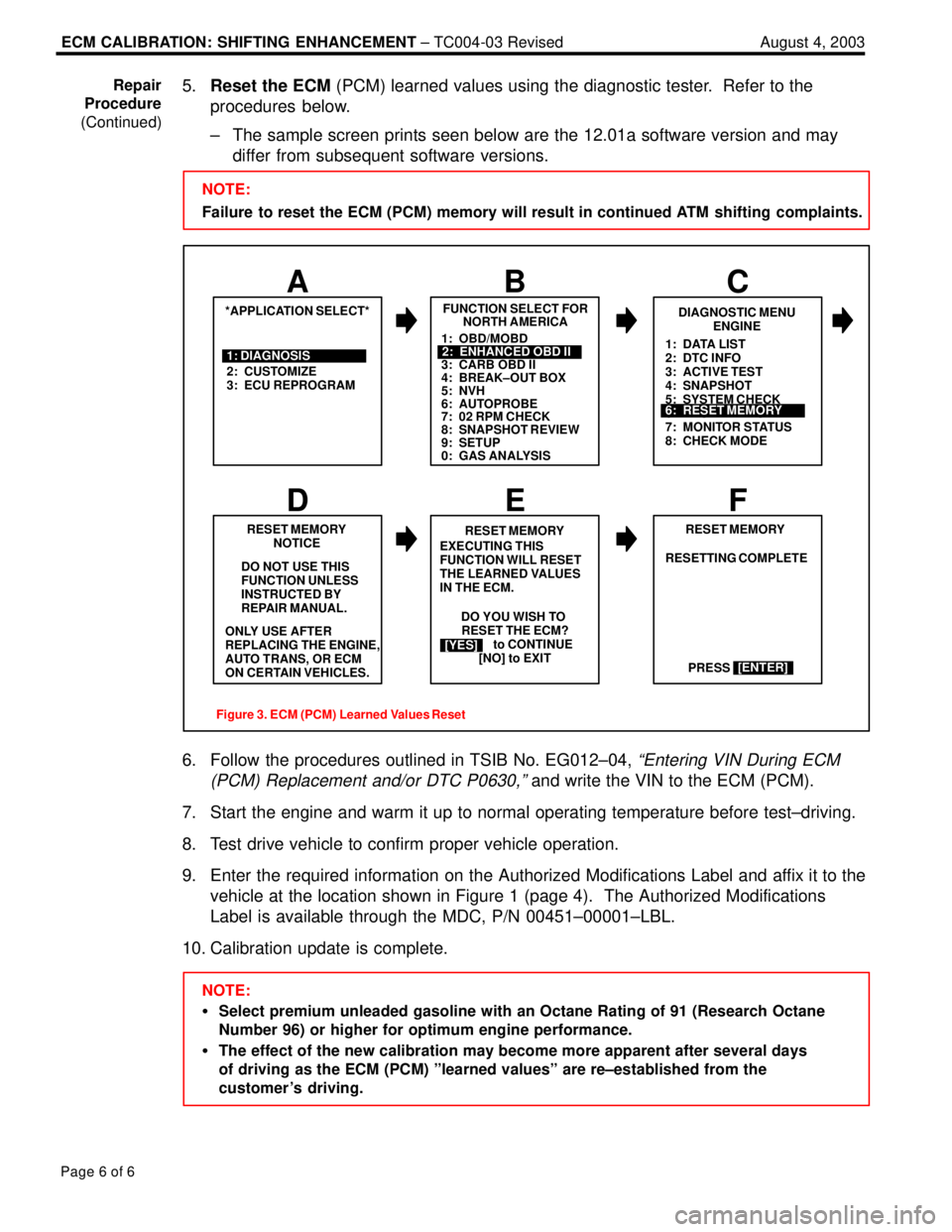Page 962 of 969

Lexus Supports ASE CertificationPage 1 of 6
Title:
ECM CALIBRATION: SHIFT FEELING
ENHANCEMENT
Models:
'02 ± '03 ES 300 & '04 ± '05 ES 330
Technical Service
Information Bulletin
August 4, 2003
TC004-03
REVISION NOTICE:
�April 1, 2005: 2004 ± 2005 model year ES 330 vehicles have been added to
Applicable Vehicles. Introduction and Note have been updated on page 1.
Calibration Identification Chart has been updated to include ES 330 calibration IDs.
�August 6, 2003: There has been a change in Warranty Time.
Previous versions of this TSIB should be discarded.
To improve the transmission shift feeling during specific operating modes, the Engine
Control Module (SAE term: Powertrain Control Module/PCM) calibration has been
revised. These improvements include:
�Reduced downshift lag when accelerating at speeds from 10 to 20 mph.
�Less gear hunting when driving on/off accelerator pedal at 20 to 30 mph
(for example: during heavy rush±hour traffic).
�Improved response rate during heavy acceleration from a stop.
NOTE:
�Version 12.01a or later Diagnostic Tester software is required to perform
this procedure.
�Before proceeding, verify the ECM (PCM) calibration has NOT been updated by
checking for the Authorized Modifications Label (shown in step 1 of the
Repair Procedure).
�Harsh ATM shifting may result if any Repair Procedure steps are omitted
(specifically steps 2 and 4 of ªFlash Reprogram ECMº on page 6).
�2002 ± 2003 model year ES 300 vehicles.
�2004 ± 2005 model year ES 330 vehicles.
OP CODEDESCRIPTIONTIMEOFPT1T2
EG5017Recalibrate ECM Engine & Transmission0.9
89666±3325#
89666±3344#
89661±33B3#
89661±33A4#
2699
Applicable Warranty*:
This repair is covered under the Lexus Federal Emissions Warranty. This warranty is
in effect for 96 months or 80,000 miles, whichever occurs first, from the vehicle's
in-service date.
* Warranty application is limited to correction of a problem based upon a customer's specific complaint.
TRANSMISSION & CLUTCH
Introduction
Applicable
Vehicles
Warranty
Information
Page 966 of 969

ECM CALIBRATION: SHIFTING ENHANCEMENT ± TC004-03 Revised August 4, 2003
Page 5 of 6
2. Connect the Diagnostic Tester to the vehicle and select CURRENT ECU CAL from
the ECU REPROGRAM MAIN MENU. Determine the vehicle's current ECU
calibration (see Figure 2).
± The sample screen prints seen below are the 12.01a software version and may
differ from subsequent software versions.
Figure 2. Determining Current ECU Calibration
ECU REPROGRAM
MAIN MENU
1: GET CAL FROM PC
2: CURRENT ECU CAL
3: UPDATE ECU CAL
4: CAL ON TESTER
5: CLEAR CAL DATA
A
CURRENT ECU CAL
B
CALIBRATION ID
33341300
53328300
NOTE:
�If Calibration ID matches ªPrevious Calibration IDº as shown in Calibration
Identification Chart on page 3, proceed with flash reprogramming.
�If Calibration ID matches ªNew Calibration IDº as shown in Calibration Identification
Chart, this vehicle has already been programmed. Refer to TIS for diagnostic
procedures applicable to any stored DTCs.
3. If ECU calibration ID is not the same as the ªNew Calibration IDº listed previously,
proceed to Flash Reprogram ECM (PCM).
4. Flash Reprogram ECM (PCM)
Follow the procedures outlined in Lexus TSIB No. SS001±01,
ªECU Flash
Reprogramming Process,º
and flash the ECM (PCM) with the new calibration
file update.
NOTE:
If the ªCheck Engineº light is ON when the ignition is turned back on to begin the
reprogramming process, a scan tool cable problem exists. Refer to TSIB No.
SS001±01,
ªECU Flash Reprogramming Process.º
Repair
Procedure
(Continued)
Page 967 of 969

ECM CALIBRATION: SHIFTING ENHANCEMENT ± TC004-03 Revised August 4, 2003
Page 6 of 6
5.Reset the ECM (PCM) learned values using the diagnostic tester. Refer to the
procedures below.
± The sample screen prints seen below are the 12.01a software version and may
differ from subsequent software versions.
NOTE:
Failure to reset the ECM (PCM) memory will result in continued ATM shifting complaints.
DO YOU WISH TO
RESET THE ECM?
[YES] to CONTINUE
[NO] to EXIT
2: CUSTOMIZE
3: ECU REPROGRAMFUNCTION SELECT FOR
NORTH AMERICA
B
*APPLICATION SELECT*
A
1: DIAGNOSISDIAGNOSTIC MENU
ENGINE
C
DO NOT USE THIS
FUNCTION UNLESS
INSTRUCTED BY
REPAIR MANUAL.RESET MEMORY
E
RESET MEMORY
NOTICE
D
[YES]
F
1: OBD/MOBD
3: CARB OBD II
4: BREAK±OUT BOX
5: NVH
6: AUTOPROBE
7: 02 RPM CHECK
8: SNAPSHOT REVIEW
9: SETUP
0: GAS ANALYSIS2: ENHANCED OBD II1: DATA LIST
2: DTC INFO
3: ACTIVE TEST
4: SNAPSHOT
5: SYSTEM CHECK
6: RESET MEMORY
7: MONITOR STATUS
8: CHECK MODE
6: RESET MEMORY
ONLY USE AFTER
REPLACING THE ENGINE,
AUTO TRANS, OR ECM
ON CERTAIN VEHICLES.EXECUTING THIS
FUNCTION WILL RESET
THE LEARNED VALUES
IN THE ECM.RESET MEMORY
RESETTING COMPLETE
PRESS
[ENTER]
Figure 3. ECM (PCM) Learned Values Reset
6. Follow the procedures outlined in TSIB No. EG012±04, ªEntering VIN During ECM
(PCM) Replacement and/or DTC P0630,º
and write the VIN to the ECM (PCM).
7. Start the engine and warm it up to normal operating temperature before test±driving.
8. Test drive vehicle to confirm proper vehicle operation.
9. Enter the required information on the Authorized Modifications Label and affix it to the
vehicle at the location shown in Figure 1 (page 4). The Authorized Modifications
Label is available through the MDC, P/N 00451±00001±LBL.
10. Calibration update is complete.
NOTE:
�Select premium unleaded gasoline with an Octane Rating of 91 (Research Octane
Number 96) or higher for optimum engine performance.
�The effect of the new calibration may become more apparent after several days
of driving as the ECM (PCM) ºlearned valuesº are re±established from the
customer 's driving. Repair
Procedure
(Continued)